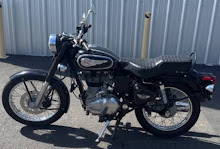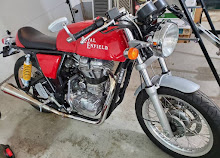The Royal Enfield Flying Flea is famous as the tiny motorcycle that went to war, being dropped by parachute with British airborne forces during World War II.
I've written a lot about the origin of the Royal Enfield Flying Flea (it was modified from the Royal Enfield Royal Baby, created to satisfy a Dutch importer's pre-war plan to compete against the made-in-Germany DKW).
I've also written a lot about the Flying Flea's role in airborne warfare.
Or the lack thereof.
Why, I've asked, if the Flying Flea flew to war, are there so few photos of it actually in action with the airborne? We see it in publicity photos, yes and being loaded on airplanes and gliders before the invasions, yes.
Yet I've only found one photograph, so far, of the Flying Flea in a combat situation.
I've even speculated that, once delivered to the battle, the Flying Flea failed to work for paratroopers facing the enemy. That's just speculation but there is some evidence that it failed.
A better answer might be that, while the airborne was fighting inland, the Flying Flea was floating at the beach.
The invasion beach, that is, with troops landing in boats on the Normandy coast.
This still doesn't explain the lack of combat photos featuring the Flea, but it does provide an alibi.
I'm not the first to think of this. For me, the best indication of its truth came recently on Jorge Pullin's blog "My Royal Enfields."
Jorge reproduced a clipping entitled "How the Little Enfield Went to War," quoting Arthur R. Bourne and mentioning the blockbuster movie "The Longest Day." The clipping must have been written sometime after the 1962 movie about the D-Day invasion, and Bourne's death in 1977.
For all I've written about the Royal Enfield Flying Flea, this is the first time I've mentioned Bourne. That is a real omission, because without him the Royal Enfield "Royal Baby," designed for civilian use, likely would not have donned warpaint at all.
Bourne edited The Motor Cycle, Britain's leading motorcycle weekly, for 23 years. Illustrating the clipping in Jorge's blog is a 1940 photo of Bourne himself, single-handedly lifting a Royal Enfield 125 then under test by the magazine.
An advocate of small, simple motorcycles like the 125cc Royal Baby, he became an advocate of their military value during World War II. He helped refigure the little Royal Enfield for combat (it gained 10 pounds in the process, he wrote).
The Motor Cycle had tested a DKW lightweight motorcycle in 1935. Bourne remembered this in his memoir "Behind the Scenes in the Vintage Years."
"It seemed to me to be a very remarkable go-anywhere lightweight motorcycle with big potentialities as an Army motorcycle, a machine that with its low weight could easily be lifted over obstacles that would defeat every other type of powered vehicle, tracked or wheeled," he wrote.
With war declared in 1939, Bourne would play an active role in enticing interest from the British Army in Royal Enfield's DKW copy, the Royal Baby. This would include him crashing around the boonies (at the risk of his life) in front of Army observers, who were flabbergasted by the performance.
Bourne was a talented motorcyclist. Presented with a hill too steep for the little motorcycle to conquer, he would dismount and walk alongside it as it climbed under power, lift it over a fence at the top, then remount. Impressive.
Particularly impressed was Britain's then brand new airborne army.
Bourne writes that Gen. Frederick "Boy" Browning, father of British airborne forces, said "we must have them!"
Quite an endorsement. Browning is the man who, when presented with the plan for the airborne attack on Arnhem, famously warned that it might be going "a bridge too far." He knew what the airborne troops needed.
But landing by boat?
In his memoir Bourne writes that without the Dutch-inspired Royal Enfield copy of the DKW, "there would not have been one of the 12,000 and more British wartime Flying Fleas, I would not have the letter from 3 Division, one of the two assault divisions on the Normandy Beaches, saying 'They (600 of them) are just the thing for the job,' there would have been no Fleas for controlling the landing of supplies on the Beaches."
So there you have the evidence that Royal Enfield Flying Fleas were on the invasion beaches. Now here's the passage in the clipping Jorge reproduced that convinced me:
"The little bikes were destined to write their own chapter in the saga of the Longest Day; from D-Day onward, they scuttled up and down the Normandy beaches in the hands of beachmasters and their staff, directing and marshalling the incoming waves of troops and supplies like mechanized sheepdogs. And that wasn't in the film!"
The passage is not marked as a direct quote from Bourne, but the article quotes him throughout and obviously was informed by him. Disappointment at the absence of his contribution to the invasion is obvious.
For millions, around the world, "The Longest Day" remains the definitive impression of what happened on D-Day. The Royal Enfield Flying Flea may not have been in the movie.
But it WAS there.
Oh, just one other thing: there is this photo, from the Imperial War Museum, and captioned, on the back "With the Glider Troops: Commandos capture three prisoners who are evacuated in a Jeep. Sixth Airborne Division at Ranville... Taken by Sgt. Christie 6.6.44."
 |
| Taken on D-Day, photo shows a motorcycle on hood of British Jeep. (Copyright: IWM B 5203) |
So here is a photo taken on D-Day June 6, 1944 showing British soldiers, gliders, and a Jeep with a light motorcycle on the hood. I at first assumed the motorcycle would be a Flying Flea plopped on a Jeep by airborne troops.
But, no.
It has been identified as James ML, a different two-stroke 125cc motorcycle used by British forces.
I think the British soldier sitting on the Jeep windscreen has his left foot on the distinctive side-mounted toolbox of the James. And I think I see the big external flywheel of the James, its curved bottom visible just above the center of the white star on the Jeep hood. (Yes, British forces of the time did have white stars on their vehicles, as did U.S. vehicles, for easy identification from the air.)
While the motorcycle is not a Royal Enfield, the Jeep itself may be evidence that light motorcycles were used on the beaches. Note the "snorkel" emerging from the side of the hood. British Jeeps landed on the beaches had these.



























No comments:
Post a Comment